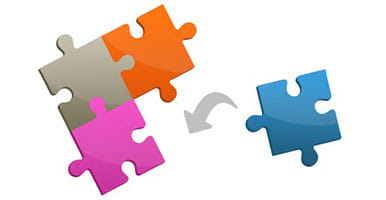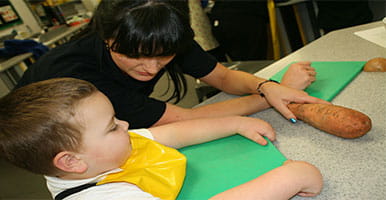Nutrition recommendations for 2-5 year olds

Why is nutrition important in young children?
Nutrients from food are important for energy, growth and development in children.
During the pre-school years children are undergoing rapid growth and development and often spend a lot of time in spontaneous physical activity. It is important children get enough energy to meet their high nutritional needs without exceeding their energy requirements.
In the short term, a child’s diet impacts their growth and development. Poor nutrition is linked to many common childhood conditions (e.g., iron deficiency, anaemia, tooth decay and vitamin D deficiency).
In the longer term, a child’s diet can influence their risk in adult life of developing conditions such as coronary heart disease, diabetes and obesity.
The Eatwell guide
The Eatwell guide is aimed at children aged over five years old and adults and represents the overall balance of a healthy diet and how much of what is eaten should come from each food group.
Using the Eatwell guide with pre-school children
Under 2 years – children of this age have different nutritional needs, therefore the Eatwell Guide should not be used. See sections on infant feeding and introducing complementary foods for nutritional guidance from birth to 2 years.
Children aged 2-5 years - children can gradually move towards eating the same foods as the family, following the general recommendations in the Eatwell Guide. When drawing on the Eatwell Guide for this age group, it is important to remember the following points:
- The calorie requirements shown on the Eatwell guide apply to adults and not children. The focus for young children should be to offer 3 main meals and 2-3 nutritious snacks each day, including a good balance of food from all the food groups.
- Foods offered to this age group should be less strict on fat. Young children need a more energy dense diet so skimmed milk and products that are aimed at older children and adults aren’t suitable for this age group (they also contain less fat-soluble vitamins, e.g., Vitamin A). If the child is a good eater and they are growing well, semi skimmed milk and lower fat dairy products can start to be introduced from the age of two, so that by the time they are five years old they can be following a healthy low fat diet suitable for older children and adults.
- Children in this age group need a mixture of both white and wholemeal/wholegrain starchy foods. High fibre foods can fill a child up before they have taken in all the energy they need and can also result in poor absorption of some minerals (such as calcium and iron).
Which foods? And how much?
Children should be offered food in the right proportions from the four main food groups each day to ensure they are getting a good balance of food and all the nutrients they need.
Recommended portions of each food group for pre-school children
- Potatoes, bread, rice, pasta and other starchy carbohydrates: Offered at each meal and as some healthy snacks, they should make up a third of the food served each day
- Fruit and vegetables: at least 5 different fruits and vegetables each day (approx. 40g per portion)
- Dairy (and alternatives): Offered at 2-3 meals and snacks each day
- Beans, pulses, fish, eggs, meat and and other proteins: 2 portions of meat and fish or 2-3 portions of vegetarian alternatives.
The First Steps Nutrition Trust provide a series of nutritional guides on food choices, snacks and portion sizes for children aged 1-4 years (including a guide for vegan infants and under 5s). The guides can either be downloaded or ordered in hard copy, and are very useful to support discussions with parents/carers about food choices.
For more information on what each of the food groups contain click on each of the drop-down boxes below:
Faq Items
Potatoes, bread, rice, pasta and other starchy foods
Fruit and vegetables
Dairy and alternatives
Beans, pulses, fish, eggs, meat and other proteins
Nutrients in young children’s diets
Click on the drop-down boxes to find out more about key nutrients needed in children’s diets.
Faq Items
Iron
Fats
Foods and drinks high in added sugars
Salt
Drinks - what is recommended and how much?
- Children should be offered a drink at each meal and snack.
- Water should be available in between these times.
- Drinks should be offered in an open cup or free flowing beaker.
The British Dietetic Association recommend that an open cup should fully replace a bottle at around 1 year of age. A free-flow, lidded beaker (that lets the liquid run out when held upside down) is also suitable, but the lid should be removed to make an open cup as soon as the infant has learned how to drink.
The amount of fluid that a child needs can depend on a number of factors such as age, gender, activity levels and the weather. How much they drink will be individual to the child but as a guide adequate fluid intake from drinks should be:
- 2-3 year olds: 1040ml/day
- 4-8 year olds: 1280ml/day
Tips
- Water and plain milk are the best drinks to offer children as they will not damage teeth.
- Fizzy drinks and energy drinks are not suitable for this age group. Sugary and fizzy drinks offered before mealtimes can fill children up and reduce their appetite at mealtimes.
- Squash should also be avoided as this can be damaging to teeth (even the low sugar varieties).
- Tea and coffee are not suitable drinks for children aged 2-4 years as they contain tannins which can inhibit the absorption of iron from foods.
- Pure fruit juice can be offered at mealtimes only and for this age group it should be served as half pure juice/half water.
- From the age of 5 children can be given undiluted pure fruit juice but make sure this is still at mealtimes only and a small glass once a day (150ml).
- Avoid ‘fruit juice drinks’ as these contain only a small amount of fruit juice and have added sugar.



